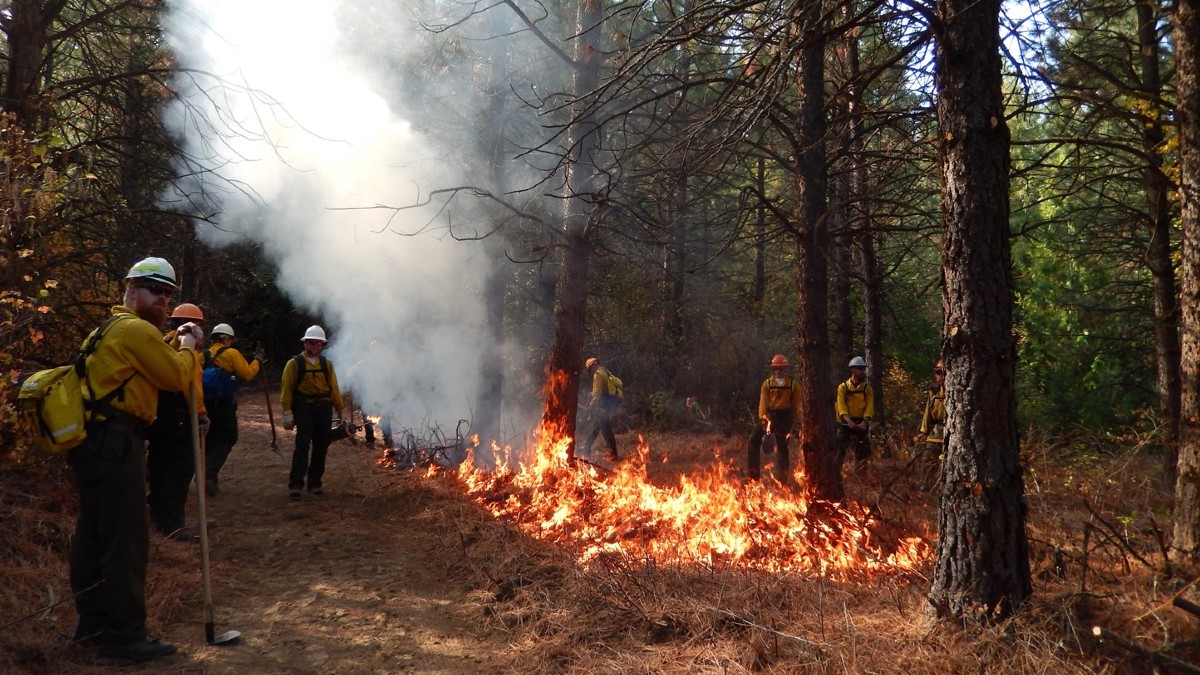Using Active Fire Behavior and LiDAR Data to Predict Long-Term Fire Effects on Mature Trees
August 02, 2023
While still early in the fire season, so far in 2023 the National Interagency Fire Center reports that wildfires have burned nearly 1.2 million acres in the United States. And with the increasing hot and dry conditions across much of the western U.S., it is highly likely that the acreage burned by wildfires will increase significantly by the end of the year.
Understanding and predicting the effects of these fires on individual trees and forests is of critical importance to resource managers, as well as scientists focused on fire effects modeling. While traditional remote sensing methods from satellite imagery can be very helpful in characterizing fuels and changes in forest canopies, these approaches often provide limited information on the structural changes and growth dynamics of surviving trees. Such information is important not only to forest managers as they consider how to manage post-fire forests, but also to fire effects modelers that are looking for more accurate approaches to determine and detect fire effects, such as tree injury and mortality.
One way that researchers in the Department of Forest, Rangeland and Fire Sciences and Department of Earth and Spatial Sciences at the University of Idaho (U of I), in partnership with the U.S. Forest Service Rocky Mountain Research Station and Northwest Management, Inc., are looking to improve our ability to predict fire effects on individual trees and forests is by integrating active fire observations into fire effects assessments. A critical piece of this effort is collecting structure and growth measurements using airborne scanning light detection and ranging (LiDAR), commonly referred to as airborne laser scanning. LiDAR provides a three-dimensional view of trees and forests and is quickly becoming an industry standard in providing accurate measurements of many attributes of forest structure, including tree height and canopy cover.
“While our team at U of I has developed a good understanding of how conifer saplings respond to fires of varying intensities using U of I’s Fire Combustion Lab, we do not have a good understanding of how mature trees are affected by fire” says Aaron Sparks, Research Assistant Professor in the University of Idaho’s Department of Forest, Rangeland and Fire Sciences. “This is for good reason as burning and measuring large trees is a huge effort.”
Utilizing the University of Idaho Experimental Forest and recent LiDAR acquisitions, Sparks and his research team set out to answer some of these questions about fire effects on mature trees. Specifically, the team wanted to understand how variable surface fire intensity impacts longer-term (~2-8 years post- fire) mature Ponderosa pine height growth. To achieve this, the team assessed growth effects in mature Ponderosa pine stands that were burned under controlled conditions in October 2014. A suite of common fire behavior metrics including flame length, rate-of-spread, and flame residence time were measured during the 2014 prescribed burn and linked with pre- and post-fire height measurements of trees using a combination of field surveys and LiDAR acquisitions.
In a recent paper published in Forest Ecology and Management, the U of I-led research team reported their initial results. Overall, they observed reduced height growth 5-8 years post-fire in trees exposed to greater fire intensities, highlighting the persistence of fire impacts on mature Ponderosa pine trees. While understanding these relationships for a fire-adapted species like Ponderosa pine is important, the results also highlight an important step forward in fire effects modeling. “Linking fire intensity and post-fire growth is a key step forward as these relationships can help us build predictive models,” says Sparks, “which are important for informing forest managers on potential reductions in growth and yield and improving existing fire effects models. This is one of the most exciting aspects of the study is that it provides a foundation for quantitative assessments of not only fire effects, but also other forest stressors like drought, from the individual tree to the landscape scale.”
An important aspect of this research is the collaborative team of university, agency, and industry scientists, staff and students. “This study was successful in part due to the over 21 U of I students and UIEF forest staff who assisted with planning and implementing the thinning and prescribed fire treatments, and forest industry partners who provided multiple airborne lidar datasets,” says Sparks.
—
Article by Charles Goebel, Department of Forest, Rangeland and Fire Sciences
Published August 2023.

About the University of Idaho
The University of Idaho, home of the Vandals, is Idaho’s land-grant, national research university. From its residential campus in Moscow, U of I serves the state of Idaho through educational centers in Boise, Coeur d’Alene and Idaho Falls, nine research and Extension centers, plus Extension offices in 42 counties. Home to nearly 11,000 students statewide, U of I is a leader in student-centered learning and excels at interdisciplinary research, service to businesses and communities, and in advancing diversity, citizenship and global outreach. U of I competes in the Big Sky and Western Athletic conferences. Learn more at uidaho.edu.






